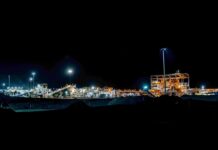Gold to become Australia’s second-largest export earner

Gold is expected to overtake LNG to become Australia’s second highest value export in FY26, according to the September 2025 Resources and Energy Quarterly (REQ).
Australia’s gold export earnings rose 42% to $47b in FY25 and is forecast to grow a further 28% to $60b in FY26 before stabilising in FY27.
That track will see gold become Australia’s second-largest export earner after iron ore.
According to the Department of Industry, Science and Resources’ (DIRS) REQ, gold prices climbed above $5600/oz (US$3700/oz) in mid-September and is forecast to remain above $5100/oz (US$3,400/oz) as global demand for safe-haven assets persists.
This increase in gold prices comes as US interests cuts occur — lowering the opportunity cost of holding gold — and worries rise over the US fiscal outlook and inflation rate.
These high gold prices have built up global mine supply and recycling in exceeding elevated levels of gold demand. The supply surplus should maintain over the next couple of years, according to DIRS. However, the Australian resource and energy export earnings are forecast to decline by 5% to $369b in FY26, down from $385b in FY25. Additionally, a further fall to $354b is forecast in FY27, consistent with previous forecasts. Resulting from this, higher prices for growing volumes of gold exports will offset the impact of weaker metallurgical coal and LNG prices in FY26 and FY27.
Upward revisions to the September 2025 REQ lifted export forecasts by $4b for FY26 and $8b for FY27, reflecting stronger expected prices and output.
Minerals Council of Australia chief executive Tania Constable says this unprecedented surge is being driven by record global prices and expanding mine output, combining to deliver a renewed period of strength for Australia’s gold industry.
“The strength of Australia’s gold industry underscores the vital contribution mining makes to the nation’s prosperity,” she said.
“Higher export earnings will flow directly to governments through increased royalty and company tax payments, helping to fund hospitals, schools, infrastructure and the essential services Australians rely on.
“Australia remains the world’s third-largest gold producer, with output expected to rise from 293t in FY25 to 369t in FY27.
“New and expanded projects across the country — including mill upgrades, extensions and new mines — are set to add around 67t to national production.
“High prices are also reviving exploration and investment, particularly for gold and copper-gold projects, reinforcing Australia’s position as a trusted and competitive global supplier.
“But this surge cannot be taken for granted. Stable and enabling policy settings, together with streamlined regulations, are necessary to attract investment, lower costs and ensure Australia fully capitalises on any upswing in the commodity cycle and safeguards the economy when prices fall.
“When policy is predictable and investment conditions are strong, the mining industry can turn global opportunity into local jobs, community development and long-term economic growth.
“Gold will remain a cornerstone of Australia’s economic resilience, supporting national income, regional economies and investment well beyond the current price cycle.”






















